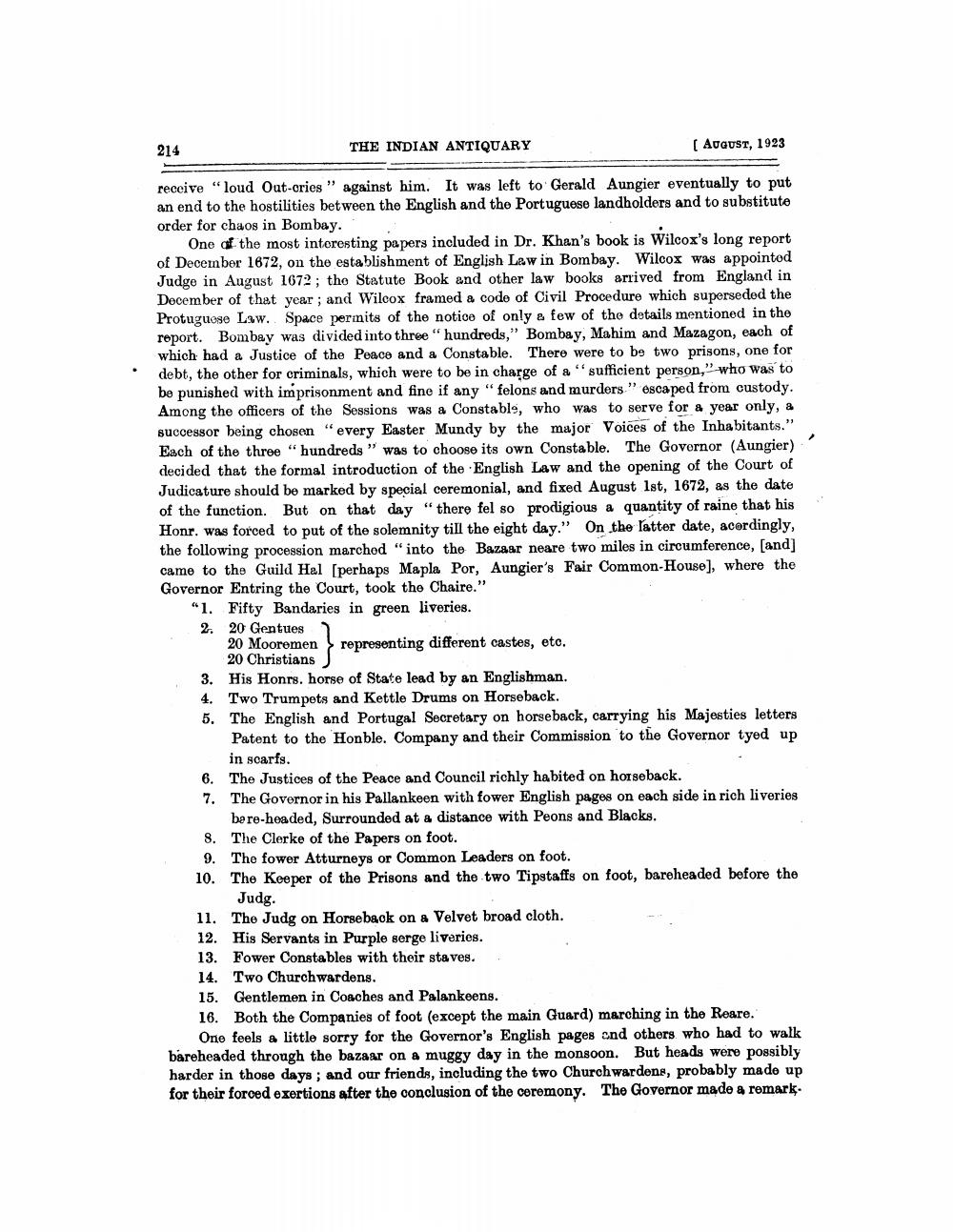________________
214
THE INDIAN ANTIQUARY
[ AUGUST, 1923
receive "loud Out-ories against him. It was left to Gerald Aungier eventually to put an end to the hostilities between the English and the Portuguese landholders and to substitute order for chaos in Bombay.
One of the most interesting papers included in Dr. Khan's book is Wilcox's long report of December 1672, on the establishment of English Law in Bombay. Wilcox was appointed Judge in August 1672; the Statute Book and other law books arrived from England in December of that year; and Wilcox framed a code of Civil Procedure which superseded the Protuguese Law. Space permits of the notice of only a few of the details mentioned in the report. Bombay was divided into three "hundreds," Bombay, Mahim and Mazagon, each of which had a Justice of the Peace and a Constable. There were to be two prisons, one for debt, the other for criminals, which were to be in charge of a "sufficient person," who was to be punished with imprisonment and fine if any "felons and murders" escaped from custody. Among the officers of the Sessions was a Constable, who was to serve for a year only, a successor being chosen "every Easter Mundy by the major Voices of the Inhabitants." Each of the three "hundreds " was to choose its own Constable. The Governor (Aungier) decided that the formal introduction of the English Law and the opening of the Court of Judicature should be marked by special ceremonial, and fixed August 1st, 1672, as the date of the function. But on that day "there fel so prodigious a quantity of raine that his Honr. was forced to put of the solemnity till the eight day." On the latter date, acordingly, the following procession marched "into the Bazaar neare two miles in circumference, [and] came to the Guild Hal [perhaps Mapla Por, Aungier's Fair Common-House], where the Governor Entring the Court, took the Chaire."
"1. Fifty Bandaries in green liveries.
2. 20 Gentues 20 Mooremen
20 Christians
representing different castes, etc.
3. His Honrs. horse of State lead by an Englishman.
4. Two Trumpets and Kettle Drums on Horseback.
5. The English and Portugal Secretary on horseback, carrying his Majesties letters Patent to the Honble. Company and their Commission to the Governor tyed up
in scarfs.
6. The Justices of the Peace and Council richly habited on horseback.
7. The Governor in his Pallankeen with fower English pages on each side in rich liveries
be re-headed, Surrounded at a distance with Peons and Blacks.
8. The Clerke of the Papers on foot.
9. The fower Atturneys or Common Leaders on foot.
10. The Keeper of the Prisons and the two Tipstaffs on foot, bareheaded before the Judg.
11. The Judg on Horseback on a Velvet broad cloth.
12. His Servants in Purple serge liveries.
13. Fower Constables with their staves.
14. Two Churchwardens.
15. Gentlemen in Coaches and Palankeens.
16. Both the Companies of foot (except the main Guard) marching in the Reare.
One feels a little sorry for the Governor's English pages and others who had to walk bareheaded through the bazaar on a muggy day in the monsoon. But heads were possibly harder in those days; and our friends, including the two Churchwardens, probably made up for their forced exertions after the conclusion of the ceremony. The Governor made a remark.




